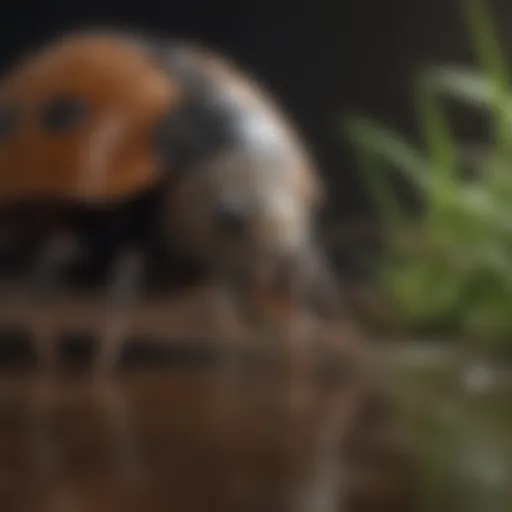Effective Strategies to Keep Moths Out of Your Home and Protect Your Belongings


Preventive Pest Control Strategies
When it comes to preventing pesky moths from infiltrating your living space, implementing preventive pest control strategies is paramount. Your first line of defense begins with safeguarding the exterior of your house. Sealing cracks and crevices that serve as potential entry points for moths is essential. Additionally, regular debris clearing around the perimeter of your home can help deter these unwanted visitors. Creating barriers to prevent pests, including moths, from entering your house is a proactive measure to maintain a moth-free environment.
House Exterior Protection
Protecting the exterior of your house is crucial in the battle against moths invading your living space. Simple tips such as sealing any visible cracks or gaps can significantly reduce the chances of moth infestations. Regularly inspecting and clearing debris like fallen leaves or branches near your house can eliminate potential hiding spots for moths. By taking these precautionary steps, you can fortify your home against moth intrusions.
Yard Maintenance
Keeping your yard well-maintained plays a pivotal role in overall pest prevention, including moths. Essential yard care routines such as trimming overgrown vegetation and maintaining a tidy outdoor space can deter pests from taking residence near your home. Implementing methods like proper waste disposal and minimizing standing water sources in your yard can contribute to creating a pest-free environment.
Indoor Cleanliness
Maintaining cleanliness indoors goes a long way in deterring moths and other pests from settling in your living quarters. Following expert cleaning tips and techniques can not only enhance the aesthetics of your home but also contribute to making it less attractive to moths. Creating a pest-resistant indoor environment through regular cleaning and decluttering can significantly reduce the risk of moth infestations.
Garbage Disposal
Efficient waste disposal methods are essential in the fight against moth infestations. Properly securing and disposing of garbage can prevent attracting moths and other pests into your home. Emphasizing the importance of proper garbage disposal practices can help maintain a clean and moth-resistant living environment.
Other Pest Prevention Strategies
In addition to the essential preventive measures, there are various innovative ways to safeguard your home from pests, including moths. Exploring alternative strategies such as using natural repellents or introducing pest-deterring plants can complement your pest control efforts and promote a pest-free household.
Understanding Moths
Moths, tiny yet notorious pests, can wreak havoc inside homes. Understanding these winged intruders is crucial to effectively prevent their entry. By delving into the intricacies of moth behavior and preferences, homeowners gain valuable insights into creating an inhospitable environment for these fluttering nuisances. Recognizing the specific types of moths that might infest your living space enables proactive measures tailored to deter each variety. Shedding light on the life cycle and habits of moths empowers individuals with the knowledge needed to target vulnerabilities and shield their homes from potential infestations.
Types of Moths


There exist various types of moths that house owners should be wary of, each with its distinct characteristics and inclinations. Clothes moths, such as the common webbing and casemaking moths, are notorious for feeding on fabrics. Food moths, like Indian meal moths, contaminate stored food products. Pantry moths, primarily the Mediterranean flour moth, target grains and cereals. Understanding these different species is crucial in implementing tailored prevention strategies to thwart specific moth threats effectively.
Behavior of Moths
Moth behavior is guided by their survival instincts and reproductive needs. These nocturnal creatures are drawn towards light sources, leading them to windows and doors. Moths lay eggs near suitable larvae food sources, such as fabric, grains, or pet food. Understanding these behavioral patterns aids in intercepting moths before infestations escalate. By comprehending their attraction to certain materials and environments, homeowners can modify living conditions to repel moths and safeguard their homes.
Signs of Moth Infestation
Recognizing the early signs of a moth infestation is vital for prompt action. The presence of adult moths fluttering near closets or food storage areas is a red flag. Additionally, discovering moth larvae or silk webbing on clothes or food packages indicates an infestation. Damage to fabrics, rugs, or stored food items signals a thriving moth population. Awareness of these signs prompts homeowners to implement preventive measures swiftly and efficiently to mitigate further infestation risks.
Preventive Measures
In the realm of battling unwanted moth intrusions into the sanctity of your home, preventive measures stand as stalwart guardians. By availing yourself of the arsenal of techniques elucidated within this article, you fortify your residential bastion against these fluttering invaders. The benefits of embracing preventive measures go beyond mere repellence; they entail safeguarding your abode and cherished belongings from the insidious harm moths can wreak.
Sealing Entry Points
Inspecting Windows and Doors
In the pursuit of fortification against moth infiltration, a pivotal strategy is diligently inspecting windows and doors. This undertaking proves instrumental in identifying potential weak points that crafty moths may exploit to gain access. The meticulous examination of these openings not only bolsters your defenses but also shields against other unwelcome guests, making it a judicious choice for inclusion in this guide.
Installing Screens
Another formidable barricade against moth incursions is the strategic placement of screens. These fine mesh barriers act as sentinels, warding off fluttering foes while permitting fresh air to grace your habitat. The beauty of screens lies in their unobtrusive nature, seamlessly blending protection with functionality for a harmonious living environment.
Repairing Cracks and Gaps
The art of repairing cracks and sealing gaps elevates your moth-proofing endeavors to new heights. By mending these architectural imperfections, you eliminate potential entry points for moths, leaving them thwarted at the threshold. While this technique boasts undeniable advantages, it is prudent to consider the time and effort investments required, weighing them against the invaluable protection it affords.
Proper Storage Techniques
Using Airtight Containers


Embracing the use of airtight containers emerges as a cornerstone in the fortress of moth prevention. These hermetic vessels act as impenetrable vaults, safeguarding your textiles and linens from moth-induced peril. The unique feature of airtight containers lies in their ability to deny moths access, making them a favored choice in preserving your possessions from harm.
Regularly Cleaning Storage Areas
In the battle against moths, regular cleaning of storage areas stands as a potent weapon in your arsenal. The act of meticulous cleaning not only banishes dust and debris but also eradicates potential moth havens. While the advantages of this practice are manifold, its diligence requirement should be factored into your maintenance routine, ensuring sustained protection against these winged adversaries.
Avoiding Overcrowding
The philosophy of avoiding overcrowding within storage spaces serves as a strategic maneuver in moth deterrence. By maintaining a clutter-free environment, you deny moths harborage, rendering your storage areas inhospitable to these textile-devouring pests. While the benefits of decluttering are evident, it is essential to strike a balance to avoid inadvertently creating new organizational challenges.
Natural Moth Repellents
Lavender
Enter the realm of natural moth repellents, where the soothing aroma of lavender reigns supreme. This fragrant deterrent not only pleases the olfactory senses but also repels moths with unparalleled efficacy. The unique feature of lavender lies in its dual functionality as a delightful scent and a potent moth adversary, making it a popular choice for those seeking a harmonious blend of utility and allure.
Cedar Wood
Step into the majestic world of cedar wood, a stalwart defender against moth incursions. The aromatic allure of cedar not only imbues your abode with a pleasant scent but also repels moths through its inherent properties. The distinct feature of cedar wood lies in its dual functionality as a natural embellishment and a formidable moth deterrent, rendering it a preferred choice for those embracing eco-friendly pest control methods.
Mint
Finally, we delve into the refreshing realm of mint, a versatile herb renowned for its culinary and repellent properties. Mint serves as a fragrant shield against moths, imbuing your living spaces with its invigorating essence while warding off unwanted guests. The distinctive feature of mint is its multifaceted utility, offering both sensory delight and pest-repelling prowess, positioning it as a valuable asset in your moth management repertoire.
Maintaining Cleanliness
Maintaining cleanliness in your home plays a crucial role in preventing moth infestations. By adhering to regular cleaning practices, you can create an environment hostile to moths and protect your belongings effectively. Proper cleanliness not only removes existing moth larvae and eggs but also eliminates attractants that draw moths into your living space. Consistent cleaning efforts contribute significantly to maintaining a moth-free household.
Regular Cleaning Practices


Vacuuming
Vacuuming is an essential aspect of maintaining cleanliness in your home and combating moth infestations. By vacuuming regularly, you can effectively remove moth eggs, larvae, and adult moths from carpets, rugs, and upholstery. The key characteristic of vacuuming lies in its ability to reach deep into fibers and crevices where moths tend to hide. This method is popular due to its efficiency in reducing moth populations and limiting their ability to reproduce. However, it is essential to empty the vacuum bag or canister promptly to prevent moths from escaping and re-infesting your home.
Laundering
Laundering your clothes, linens, and other fabrics is a critical step in preventing moth infestations. Washing these items in hot water helps kill moth eggs and larvae, ensuring that your belongings remain free from destructive moth activity. The unique feature of laundering lies in its ability to sanitize fabrics thoroughly, removing any existing moth contaminants. While laundering is a beneficial choice for addressing moth infestations, it is important to follow proper washing and drying techniques to prevent potential moth resurgence.
Dusting
Dusting your home regularly is essential for controlling moth populations and eliminating potential food sources for these pests. Dusting removes accumulated debris, dead insects, and shed skin cells that can attract moths. The key characteristic of dusting is its ability to disrupt moth habitats and hinder their breeding cycles. This popular cleaning method helps reduce moth infestation risks and maintains a clean and inhospitable environment for these pests. However, using a damp cloth or microfiber duster is recommended to capture and remove dust effectively.
Proper Waste Management
Taking Out Trash Regularly
Regularly taking out the trash is crucial in preventing moth infestations by removing food sources that attract these pests. The key characteristic of this practice is its ability to eliminate organic matter that moths feed on, reducing the likelihood of infestation. By promptly disposing of garbage, you can keep moth-attracting odors at bay and minimize the risk of a moth population surge in your home. While taking out trash regularly offers numerous benefits in moth prevention, it is essential to secure garbage bags to prevent moth access and breeding opportunities.
Avoiding Food Spills
Avoiding food spills is paramount in deterring moth infestations and safeguarding your home against these pests. By promptly cleaning spills and crumbs, you can remove potential food sources that attract moths. The key characteristic of this practice is its preventive nature, reducing the chances of moth infestations by denying them access to food. Additionally, maintaining a clean and spill-free environment promotes overall hygiene and prevents other pests from being attracted to your home.
Cleaning Pet Areas
Keeping pet areas clean is essential for preventing moth infestations and protecting your furry companions. The unique feature of cleaning pet areas lies in its role in eliminating pet dander and organic matter that moths may target as food sources. By regularly cleaning and sanitizing your pet's living spaces, you can reduce the risk of moth infestations and ensure a healthier environment for both your pets and your family. While cleaning pet areas contributes significantly to moth prevention, it is essential to use pet-safe cleaning products and practices to avoid harming your pets.
Professional Help
When it comes to dealing with moth infestations, seeking professional help is crucial for effectively eradicating these pests. Pest control services have the expertise, experience, and necessary tools to address moth problems comprehensively. By enlisting the assistance of professionals, homeowners can benefit from customized treatment plans tailored to their specific needs and infestation levels. Furthermore, pest control experts can identify the root causes of the infestation, implement targeted solutions, and provide ongoing monitoring to prevent reoccurrence.
Consulting Pest Control Services
Consulting pest control services is a strategic move when faced with persistent moth issues. These professionals conduct thorough assessments to determine the extent of the infestation and develop a strategic pest management plan. Through their specialized knowledge, they can pinpoint vulnerable areas in the home that may attract moths, such as food sources or hiding spots. Pest control experts utilize safe and effective treatment methods to eliminate moths, ensuring minimal impact on the environment and residents. Additionally, their expertise extends to offering valuable advice on preventive measures to safeguard the home against future infestations.
Implementing Preventive Treatments
Implementing preventive treatments is a proactive approach to ward off potential moth problems. By taking preventative measures, homeowners can create an inhospitable environment for moths to thrive. This includes using moth repellents strategically placed in susceptible areas, sealing off entry points, and maintaining cleanliness to eliminate attractive breeding grounds for moths. Integrated pest management techniques, such as eco-friendly sprays or traps, can also be deployed preventatively to deter moths from entering the home. Consistency in implementing preventive treatments is key to long-term moth control and ensuring a moth-free living space for homeowners.



